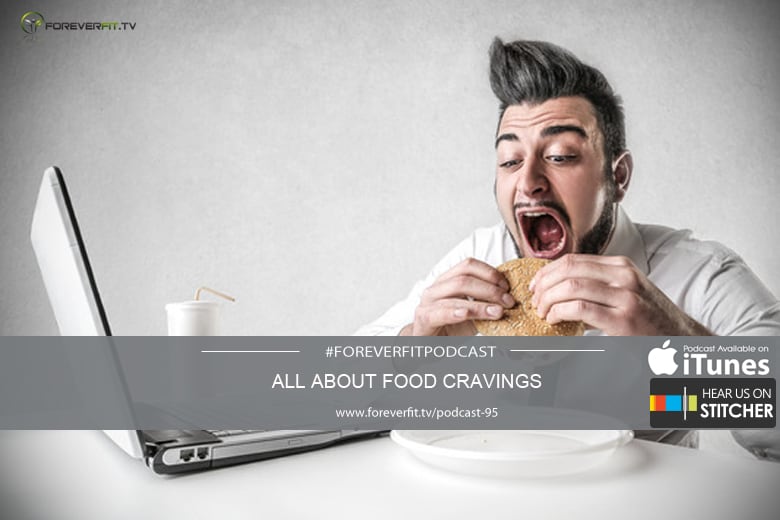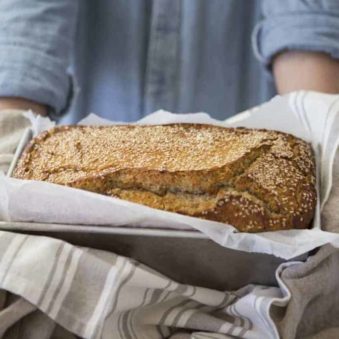Podcast # 95 – All About Food Cravings
Most of us have experienced food cravings in the past. That intense desire to devour a specific food without too much thought about the consequences. It’s not that we just want something to eat; we want salt and vinegar chips or a white chocolate Freddo. It’s really like a battle with the mind and very difficult to overcome unless you know how to control your cravings.
Surveys found that almost 100% of young women and 70% of young men experienced food cravings within a period of a year. Westerners have a habit of craving foods that a highly appealing to the palate and energy dense. So those foods that have a high sugar or high fat content, or both. This is because our brains are biologically wired to find and consume high-calorie, fatty foods. But it is making us sick. There are more and more studies to show these food cravings are leading to obesity, diabetes, sleep deprivation and eating disorders.
Our natural survival mechanisms dates back to the days of hunter-gatherers. From what scientists know about our early ancestors is that they were fixated on consuming high-calorie foods to stay alive. Eating these foods ensured they would be able to store excess calories as fat in order to survive through the lean times.
You can see where this is going right? Today with the availability of food, most of us of Western societies don’t experience those lean times thanks to the supermarkets, fast food joints and even vending machines! It was only about 10,000 years ago that people only ate the meat that they could hunt and the plants that they could gather. Not only that, these people where expending energy to get their food. How much energy do you expend when you collect a meal through the drive-thru or wonder around the supermarket?
Causes of our food cravings
According to a research article posted in the Frontiers Journal, food cravings are a multidimensional experience and can be broken into categories:
Cognitive – thinking about food
Emotional – desire to eat or changes in mood
Behavioural – seeking and consuming food
Physiological – salivation
This is a really interesting finding as we can start to pinpoint what drives our food cravings and how we can work towards controlling them.
A study published by the International Journal of Eating disorders found that more women than men were food cravers. The women in particular were much more concerned about their weight than the non-cravers of the study. What I found interesting is that women were said to experience more frequently negative feelings when indulging their cravings, whereas men experienced positive feelings more frequently. This study came to the conclusion, the food cravings were strongly associated with mood but just in a different way depending on the gender.
This was further confirmed in a study published in the Appetite Journal where food cravings, dietary restraint and mood were analysed in a group of 206 women. It found that while some food cravings related to dietary restraint, the majority were linked to emotional eating and susceptibility to hunger. The authors of the study, chose 20 women to continue the study to further understand their relationship to food cravings. This group consisted of 10 women who experienced food cravings and 10 women who rarely craved foods. They were to keep a diary which outlined the food intake, daily mood and any food craving episodes.
The eating behaviour of the women in both groups weren’t too different, however the food cravers tended to consume a diet slightly higher in energy than the non-cravers. What was interesting was that the cravers had significantly higher ratings of boredom and anxiety throughout the day and dysphoric mood was evident prior to experiencing the food cravings.
There has also been plenty of research studies to suggest mental imagery may be linked to food cravings. People with specific food cravings often have a vivid image of what that food looks like. The more vivid the picture, often the more intense the person’s craving is likely to be. This is believed to have a knock on effect to our ability to function as the mental imagery consumes our brain power. Those who were imagining a specific food were found to have less focus, recalled fewer words and took longer to solve problems than those who weren’t experiencing cravings.
The science behind making foods
Not surprisingly, food manufactures have jumped onto this attraction we have to certain foods and used it to make their own products more desirable. Food scientists spend their time making sure there is the perfect amount of salt, sugar and fat in their products for you to keep wanting to consume more and more.
Steven Witherley is a food scientists who has studied what makes certain foods tastier than others for over 20 years. He acknowledges there are two main factors that make the experience of eating more pleasurable.
1. The sensation of eating food – what is takes like, smells like and feels in the mouth.
2. The macronutrient make-up of the food – the blend of proteins, fats and carbohydrates
Taking these two factors into consideration, Witherley suggests there are specific ways in which food companies create processed foods that excite your brain and keep you buying their product.
Dynamic Contrast – this is where the one food has different sensations such as an Oreo cookie with the crunchy biscuit and creamy filling.
Salivary Response – the more saliva a food causes your body to create, the more the flavour covers your taste buds and fills your mouth. Sauces, butter, salad dressings and ice-creams are all emulsified foods that excite your brain.
Vanishing caloric density – these are foods that literally melt in your mouth. In the process they signal to your brain that you are not eating as much as you really are which leads to you overeating. Witherley points out Cheetos are a perfect example as the puff has an uncanny ability to melt away.
Sensory specific response – food manufactures don’t ever want your brain to lose the pleasure of eating a particular food, otherwise known as a sensory specific response. So they create foods that taste interesting enough to keep you excited, but don’t dull your sensory response.
Calorie density – processed foods are designed to have just the right amount of proteins, fats and carbohydrates to trick your body into thinking you’re getting nutrition but without filling you up. Your brain will think you’re getting energy by eating the product, but there are not enough calories to signal that you are full. That’s why you eat a whole bag of chips even though you are not really that hungry.
Food manufactures are spending millions of dollars to create foods that you will crave and essentially keep you buying. Combine that with clever advertising and you might think that we are all doomed!
But it isn’t only the crafty food science and our genetic makeup that has been linked to certain food cravings. Food cravings have also been associated with what our body needs in terms of a specific nutrient, vitamin or mineral. Unfortunately with the wide variety of foods on offer, we often get confused about what our bodies actually are asking for and grab for something with empty calories instead of the nutrient dense wholefoods.
So what does it actually mean when your body is craving a sugar covered doughnut?
Each individual is slightly different, but there are some guidelines to help to explain why you may be experiencing a specific food craving.
Chocolate
Chocolate is perhaps one of the more popular food cravings, in particular amongst women. Often it is an indication you might require magnesium as well as chromium, B-vitamins and/or essential fatty acids. Chocolate is actually high in magnesium, but instead of devouring a your favourite chocolate bar, it’s best to eat a square of dark chocolate greater than 70% (yes I said a square) or add raw cocoa to your smoothie. Eating plenty of dark leafy greens and including nuts and seeds in your diet is another way to keep your magnesium levels up.
Carbohydrates
Craving white flour based products such as bakery treats, chips, savoury biscuits and white breads can indicate a deficiency in the essential amino acid, tryptophan. This is helped to make the chemical serotonin which is vital in regulating your mood. Although carbohydrates don’t contain tryptophan themselves, by raising the blood sugar levels, it is believed it helps drive more of this essential amino acid to the brain. This craving can be counteracted by including more protein rich foods into your diet as well as foods high in tryptophan such as turkey, eggs and bananas.
Carbohydrate cravings can also be a sign you are deficient in chromium, so upping your intake of chromium rich fruit and vegetables such as apples, capsicum, spinach, avocado and broccoli can help.
Meat
Food cravings of meat can be associated with a deficiency in iron and zinc. Without iron we become fatigued and without zinc we are more susceptible to suffering colds and flus as our immune system is weakened. Consuming red meat at least once a week can help up your levels of iron and zinc. Other sources of zinc include lentils, spinach, pumpkin seeds, shellfish and cheese.
Salt
If you are reaching for salty foods this could indicate your sodium levels are too low. Often this is due to dehydration, illness or drinking alcohol. Try consume foods that are naturally high in sodium such as dried anchovies or salted popcorn. A salt food craving is also often linked to fluctuations in our stress hormones. Consuming foods rich in B vitamins such as nuts, seed, legumes, fruits and vegetables can help during periods of stress.
Pica
A pica craving is when you crave non-food items such as clay, dirt or chalk. This is seen more frequently in children than adults however, it can also occur in periods of greater nutritional need such as during pregnancy. It often means you are deficient in iron, so consuming dark green leafy vegetables, legumes, nuts and seeds can help overcome this craving.
How to kick your food cravings
Although our food cravings may be associated to how our brain is biologically wired and food scientists are designing foods hard to resist, we can work to control our cravings. This is essentially by reprogramming our brains and research shows you can do this by simply eating less junk foods. Eat heathier and you will notice your cravings for chocolate, ice cream or chips will fade over time.
Here are a few of my strategies to keep you making the right food choices and supress your food cravings until they are virtually non-existent.
1. Change your shopping style
If you have ever attempted to eat healthier, you would have heard of the tip to only shop the outer edges of the supermarket. That is because this is generally where the wholefoods are kept such as the fruits, vegetables, meats and eggs. Enter the inner ring and you are in a world of trouble as you try and navigate the shelves of chips, chocolates, lollies and soft drinks.
2. The ‘5 ingredients or less’ rule
Another good tip is to buy foods which have less than 5 ingredients listed on the package. And steer clear of the products with ingredients you can’t pronounce or don’t know what they are.
3. Eat a breakfast high in protein
There is plenty of research that suggests starting your day with a protein based meal such as eggs, chicken, nuts or seeds can help reduce your cravings as well as help people lose weight and burn calories.
4. Balance your blood sugar levels
Food cravings often come about due to your blood sugar levels being too low. When you experience low blood sugar, you will eat almost anything and in most cases it will be junk. Eating smaller meals or snacks every 3-4 hours can help you balance your blood sugar levels.
5. Create interest
You too can create interest in your food just as the food scientists focus on creating dynamic contrast with their processed products. This is important to keep your mind interested and to ensure the food is desirable to all your senses. Mix a crunchy carrot with a creamy guacamole, add pomegranates into a salad or top your Greek yoghurt with nuts and seeds.
6. Curb your emotional eating
Studies show that we have an emotional attachment to food and stress or mood leads to food cravings. If this is you, it is time to find a better way to cope with your stress and deal with emotions. Changing our behaviour from reaching for a sugary treat when stress arises to going for a walk or doing a workout can reduce our tendency to eat unhealthy foods.
There are several powers at force when it comes to food cravings. There is our biologically make-up of consuming high calorie foods for survival, our tendency to use food to cope with changes in emotions and the power of food scientists designing foods that keep us coming back for more. But these are all moveable focuses and once we understand food cravings, we can learn to control and essentially eliminate them from our lives.
Podcast: Play in new window | Download
Subscribe: RSS








